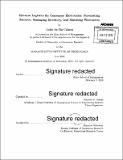| dc.contributor.advisor | Stephen C. Graves. | en_US |
| dc.contributor.author | Calmon, André du Pin | en_US |
| dc.contributor.other | Massachusetts Institute of Technology. Operations Research Center. | en_US |
| dc.date.accessioned | 2015-09-17T19:07:20Z | |
| dc.date.available | 2015-09-17T19:07:20Z | |
| dc.date.copyright | 2015 | en_US |
| dc.date.issued | 2015 | en_US |
| dc.identifier.uri | http://hdl.handle.net/1721.1/98720 | |
| dc.description | Thesis: Ph. D., Massachusetts Institute of Technology, Sloan School of Management, Operations Research Center, 2015. | en_US |
| dc.description | Cataloged from PDF version of thesis. | en_US |
| dc.description | Includes bibliographical references (pages 147-150). | en_US |
| dc.description.abstract | The goal of this thesis is to describe, model, and optimize reverse logistics systems commonly used in the Consumer Electronics industry. The context and motivation for this work stem from a collaboration with an industrial partner, a Fortune 500 company that sells consumer electronics and is one of the top retailers in its sector. The thesis is divided into three parts. In the first part of the thesis we model and analyze the problem of forecasting failures of new products. When a new device is introduced to the market there is limited information available about its failure time distribution since most devices have yet to fail. However, there is extensive failure time data for prior devices, as well as evidence that the failure time distribution for new devices can be forecast from the data for prior devices. In this setting, we propose two strategies for forecasting the failure distribution of new products that leverages the censored failure observations for the new devices as well as this massive amount of data collected for prior devices. We validate these strategies using data from our industrial partner and using data from a social enterprise located in the Boston area. The second part of the thesis concerns inventory management in a reverse logistics system that supports the warranty returns and replacement for a consumer electronic device. This system is a closed-loop supply chain since failed devices are refurbished and are kept in inventory to be used as replacement devices or are sold through a side-sales channel. Furthermore, managing inventory in this system is challenging due to the short life-cycle of this type of device and the rapidly declining value for the inventory that could potentially be sold. We propose a stochastic model that captures the dynamics of inventory of this system, including the limited life-cycle and the declining value of inventory that can be sold off. We characterize the structure of the optimal policy for this problem. In addition, we introduce two heuristics: (i) a certainty-equivalent approximation, which leads to a simple closed form policy; and (ii) a dual balancing heuristic, which results in a more tractable newsvendor type model. We also develop a robust version of this model in order to obtain bounds for the overall performance of the system. The performance of these heuristics is analyzed using data from our industrial partner. The final part of the thesis concerns the problem faced by a consumer electronics retailer when matching devices in inventory to customers. More specifically, we analyze a setting where there are two warranties in place: (i) the consumer warranty, offered by the retailer to the consumer, and (ii) the Original Equipment Manufacturer (OEM) warranty, offered by the OEM to the retailer. Both warranties are valid for a limited period (usually 12 months), and once warranties expire, the coverage to replace or repair a faulty device ends. Thus, a customer does not receive a replacement if he/she is out of consumer warranty, and the retailer cannot send the device to the OEM for repairs if it is out of OEM warranty. The retailer would ideally like to have the two warranties for a device being matched, i.e., the customer would have the same time left in his consumer warranty as the device would have left in the OEM warranty. A mismatch between these warranties can incur costs to the retailer beyond the usual processing costs of warranty requests. Namely, since a device can fail multiple times during its lifecycle the replacement device sent to customers that file warranty requests can lead to out-of-OEM-warranty returns. In order to mitigate the number of out-of-OEM-warranty returns, we propose an online algorithm to match customers that have filed warranty claims to refurbished devices in inventory. The algorithm matches the oldest devices in inventory to the oldest customers in each period. We characterize the competitive ratio of this algorithm and, through numerical experiments using historical data, demonstrate that it can significantly reduce out of warranty returns compared to our partner's current strategy. | en_US |
| dc.description.statementofresponsibility | by Andre du Pin Calmon. | en_US |
| dc.format.extent | 150 pages | en_US |
| dc.language.iso | eng | en_US |
| dc.publisher | Massachusetts Institute of Technology | en_US |
| dc.rights | M.I.T. theses are protected by copyright. They may be viewed from this source for any purpose, but reproduction or distribution in any format is prohibited without written permission. See provided URL for inquiries about permission. | en_US |
| dc.rights.uri | http://dspace.mit.edu/handle/1721.1/7582 | en_US |
| dc.subject | Operations Research Center. | en_US |
| dc.title | Reverse logistics for consumer electronics : forecasting failures, managing inventory, and matching warranties | en_US |
| dc.type | Thesis | en_US |
| dc.description.degree | Ph. D. | en_US |
| dc.contributor.department | Massachusetts Institute of Technology. Operations Research Center | |
| dc.contributor.department | Sloan School of Management | |
| dc.identifier.oclc | 920858977 | en_US |
